If Antarctica were music it would be Mozart. Art, and it would be Michelangelo. Literature, and it would be Shakespeare. And yet it is something even greater; the only place on earth that is still as it should be. May we never tame it.
—ANDREW DENTON
Antarctica has this mythic weight. It resides in the collective unconscious of so many people, and it makes this huge impact, just like outer space. It’s like going to the moon.
—JOHN KRAKAUER
TO THE BOTTOM OF THE WORLD
In December 1990, my good friend paleontologist Bill Hammer was riding in a helicopter headed to a series of mountain peaks sticking above the glaciers in Antarctica. He was already a veteran of polar exploration, having spent time near the South Pole with his graduate advisor John Cosgriff, who found primitive amphibians in Triassic rocks of Antarctica in 1977–1978. Cosgriff, in turn, had collaborated with Ned Colbert (see chapter 11), who had begun the process of hunting vertebrate fossils in Antarctica in 1969 with a discovery that helped confirm that Antarctica was once a part of Pangea in the Triassic. (I know Bill well as he spent his whole career teaching at tiny Augustana College in Rock Island, Illinois, whereas I spent the first three years of my career, 1982–1985, teaching at even smaller Knox College in Galesburg, Illinois, just an hour south of him. I often went up to visit him at the amazing Fryxell Geology Museum.)
Exploring for fossils in Antarctica is not for the faint of heart, nor for those who are afraid of hard work or frightening conditions. Enormous preparation is required, as well as several years of writing grants to the National Science Foundation (NSF) to propose a project that the committees of scientists at NSF will deem worthy of funding. Everything in Antarctica costs a lot more due to the logistics and equipment needed to get people out there safely and back without killing anyone. Once you have been approved for funding in competition with dozens of other scientists, you give up your Christmas holidays to be there in the peak of Austral Summer in December and January, when the temperatures are only a few degrees below freezing and there is less snow on the rocks and lots of daylight. The Austral Winter in June and July is totally dark most of the day, and temperatures are about −40°C (−40°F). Howling winds lower the wind chill to −100°F, and there is snow on all the outcrops, so few people come in the winter.
The logistical challenges are daunting enough. First you fly to New Zealand with all your winter gear packed and ready to put on when you meet your Antarctic flight. Over your long johns and regular clothes, you wear a bright red hooded polar parka for visibility on the snow, insulated snow pants, thick warm gloves, and “bunny boots” with air pockets in them for insulation. You also need tinted goggles and a knit balaclava to cover almost all of your head except your eyes, nose, and mouth. All the international scientists and staff headed toward Antarctica then board a huge C-17 Globemaster cargo plane (with the back half filled with pallets of gear secured in cargo nets) for the 5–6 hour flight to McMurdo Station, which is on the edge of the Ross Ice Shelf (figure 12.1A). McMurdo Station is a large permanent village and is the hub for all scientific expeditions in the region. It has been going for decades. It is composed of a bunch of permanent huts and buildings with a full-time staff to feed and house all the people living there or passing through, plus large areas to store equipment, supplies, fuel, and a tent city for people who are only visiting for a short time (figure 12.1B).
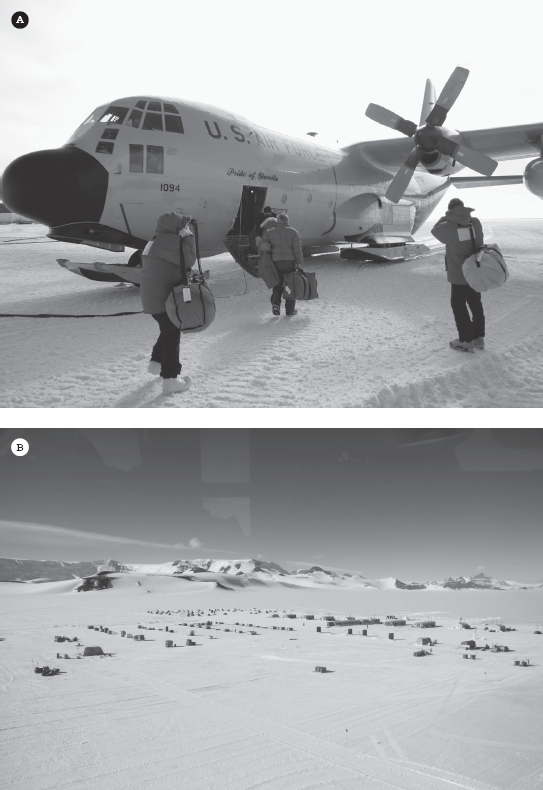
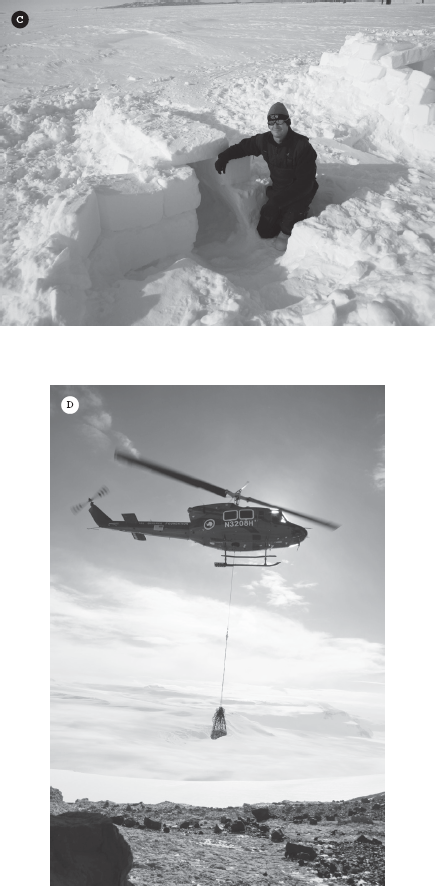
Figure 12.1
(A) A transport plane bringing the scientists to the base camp. (B) The base camp sprawls around the central buildings. (C) Nate Smith poses next to the emergency snow cave shelter that everyone must be able to build before they begin their work in Antarctica. (D) A helicopter removing a block of rock and fossil from the locality. ([A, B, D] Courtesy of P. Makovicky; [C] courtesy of N. Smith)
Before leaving McMurdo to head to your research destination, every scientist must pass a two-day survival course at Snow Camp on the Ross Ice Shelf. In addition to learning how to use all the equipment in the survival packs that you carry with you (including a polar tent and high-powered propane stove and military-grade walkie-talkies), they teach you the techniques of polar survival. You learn how to saw compacted snow into huge blocks to create a windbreak wall for your tent and to weigh down the corners of your tent against howling gales.
Then they teach you how to use a shovel to cut a deep shelter trench in the surface snow and build a roof over it of the ice blocks you removed from the trench. In an emergency, this “snow hut” can help you survive extreme conditions by protecting you from the wind and cold (figure 12.1C). You get to find out how well you built your shelter by spending the night sleeping in it. The warm polar sleeping bags keep you cozy even though you are surrounded by a virtual igloo, but you have to strip down to your underwear to get the full benefit of the sleeping bag. Getting in and out of the bag can be quite a shock! Finally, you have to practice “rescuing” someone in whiteout conditions by walking around with a white bucket on your head. You quickly learn that it is practically impossible to go anywhere when the blizzards are howling enough to produce a whiteout.
After you pass the two-day survival camp experience, you return to McMurdo and join a much smaller group of scientists carrying their own gear who will fly on the smaller C-130 Hercules cargo plane to Beardmore Glacier near the Transantarctic Mountain Range, about 90 minutes of flying time from McMurdo Station, where there is a smaller temporary scientific station. The Hercules is equipped with skis and lands on a snow runway. Sometimes the load in the back of the plane is dropped off as the plane skims along the ground in what the military calls a “combat drop”—the plane acts as if the runway is under attack and drops its load without stopping, then immediately takes off again. Finally, all your essential gear and the scientists are loaded into helicopters and flown to the top of the mountain where the outcrops and fossils are located (figure 12.1D).
After all this work and preparation, you still need to set up your remote camp and make sure the tents are properly pitched, sheltered from the wind, and weighted down. Then you finally get a chance to explore the outcrops on top of the peaks at over 13,000 feet. Unlike many other collecting areas, the fossils are not loose on the ground or easy to collect. They are deeply embedded in the rock, and usually all you can see is a cross section of bone. The air is cold and dry and it never rains, so the rocks are not weathered at all. Instead, they are incredibly hard, and ordinary hammers and picks are insufficient to recover the fossils. The explorers must bring portable rock saws to slice deep grooves around the fossil block with the saw (figure 12.2), then they use a portable jackhammer to chip away the excess rock (figure 12.3). It is important to cut the block to its minimum size to reduce the weight that has to be hauled out. Once the block is trimmed down as small as possible, ordinary chisels can be used to crack it and pry it loose from the rock. Dynamite is used occasionally to blow off an entire layer of hard rock and get to the bone-rich layer.
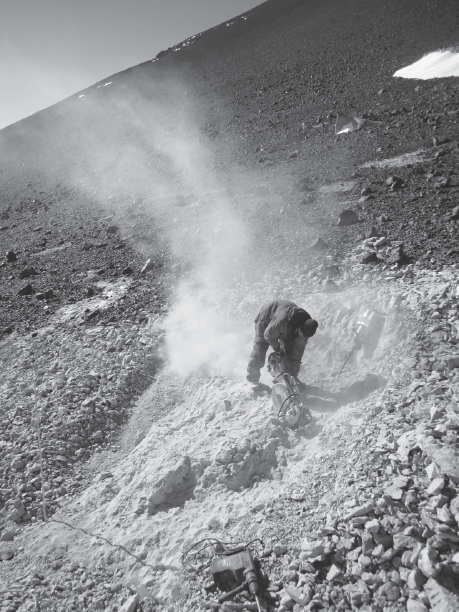
Figure 12.2
Cutting the fossil into a block with rock saws. (Courtesy of P. Makovicky)
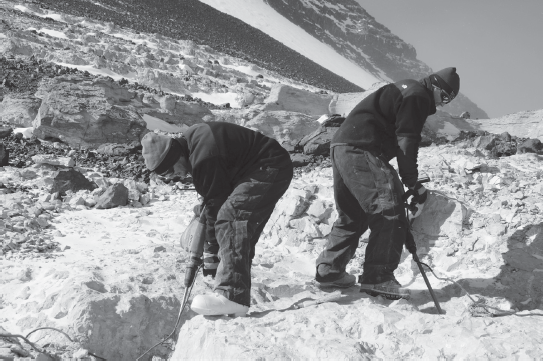
Figure 12.3
Chipping away the excess rock and reducing the weight of the cut block with jackhammers. (Courtesy of P. Makovicky)
Once the scientists have finished collecting all the blocks and preparing them to be removed, they wrap them in a cargo net and carry them to the helicopter landing spot. If the blocks weigh less than 300 pounds, they can be put directly in the chopper. If they are heavier than that, the harness of the cargo net is hooked under the belly of the chopper and lifts the entire block down to the base camp (see figure 12.1D). The helicopter pilots must be very skilled and very careful. It’s dangerous to hover a few feet above a narrow ledge on the side of a mountain because there are lots of unpredictable crosswinds and updrafts that could mean disaster.
Finally, all the blocks are loaded onto choppers for a series of trips to McMurdo where the blocks are loaded into larger wooden crates and shipped directly to the lab at the museum. Many years of hard work are required in the lab for the preparator to slowly chip away the incredibly hard sandstone and remove the bones entombed inside it.
In December 1990–January 1991, Bill Hammer was on one of these expeditions, working with David Elliot of Ohio State University. They were looking at different outcrops when Elliot came across a promising cross section of bone exposed on the top of Mt. Kirkpatrick, about 4,000 meters (13,000 feet) in elevation, only 640 kilometers (400 miles) from the South Pole. He notified Bill, and during that season Hammer excavated numerous blocks weighing 2,300 kilograms (5,100 pounds) and shipped them to Augustana College where they were prepared. By 1994, enough of the blocks had been opened and the fossils cleaned up to enable him to publish a description of the dinosaur. A lot of material had been left behind after the initial brief visit in 1990–1991, and Hammer spent several more winter breaks collecting more material. Finally, in 2011, the last part of his major quarry for dinosaurs was collected. In all, more than 5,000 pounds of rock and bones had been removed from Mt. Kirkpatrick by helicopters, spanning almost 20 years. The last expedition included Nate Smith, who had once been one of Hammer’s students at Augustana, then went on to get his PhD at the Field Museum in Chicago with Dr. Peter Makovicky working on the Antarctic dinosaurs. The circle is now complete because Smith is taking over the Antarctic research program as his mentor Hammer has just retired. Today Nate Smith is a Curator of Dinosaurs at the Natural History Museum of Los Angeles County.
ICY CRESTED LIZARD
Even as early as 1991, Hammer could see that his find was a spectacular new dinosaur, which he named Cryolophosaurus (Greek cryo for “ice,” lopho for “crest,” and saurus for “lizard”). Most of the skeleton that had been collected in the first few seasons was finally prepared, described, and published in 1994. The dinosaur’s name refers to the icy conditions where it was found and to the odd-shaped crest on its head. It resembled the Spanish comb that señoritas used to wear on the top of their head, or maybe a lock of hair sticking up like a cowlick (figure 12.4). Based on the dimensions of the preserved parts, Cryolophosaurus was a relatively large theropod for the Early Jurassic, reaching 6.5 meters (21.3 feet) in length and weighing about 465 kilograms (1,025 pounds). This specimen was a juvenile, so the adult would have been a bit larger. That’s not as big as an Allosaurus or Tyrannosaurus rex, but there were no other predators in the Early Jurassic nearly that big.
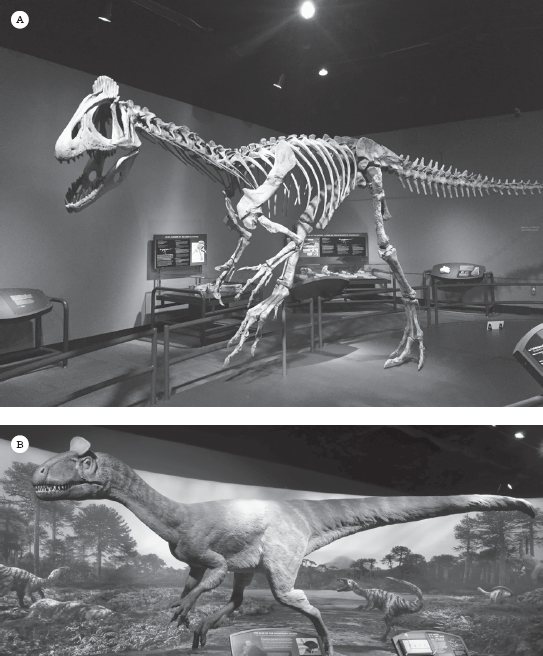
Figure 12.4
Cryolophosaurus: (A) mounted skeleton at the Field Museum of Natural History in Chicago; (B) reconstruction of the dinosaur with its distinctive crest. (Courtesy of B. McGann)
So far Cryolophosaurus is known mainly from a partial skull, a number of vertebrae and ribs, upper and lower arm bones, a thighbone, part of the hip, and several other bones including parts of the foot and ankle. (The specimens collected from 2011 to 2013 may add to this.) The thighbone is very primitive and resembles other Early Jurassic theropods such as Dilophosaurus. However, some features of the skull suggest a more advanced theropod, such as the allosaurs. A recent study found that the cast of the skull cavity revealed a brain that was relatively small and primitive and not nearly as advanced as that of later theropods. The biological relationships of Cryolophosaurus has jumped all over the theropod family tree because specialists cannot find a consistent answer when they analyze it.
The most interesting and puzzling feature of this dinosaur is the weird-looking crest on its skull (figure 12.4B). It is composed of extensions of certain skull roof bones above the eye sockets. The crests on most dinosaurs are parallel to the midline of the skull (such as the paired crests in Dilophosaurus or the single crest on Monolophosaurus), but the crest on Cryolophosaurus trends perpendicular to the midline, running across the skull from one eye socket to the other.
How was this weird crest used? We cannot really know for sure how extinct animals behaved because we only have the bones and occasionally a few other clues, such as trackways. However, other animals with headgear (antelopes and deer, for example) use their crests, horns, antlers, and other cranial features for two main functions. The most common is recognition of members of their own species and to attract mates, but some headgear is used for intimidation and in combat against other rivals in the herd. The crest of Cryolophosaurus is not very thick or robust, so we can rule out head-to-head butting or wrestling. It is likely that the crest did serve for species recognition, mate attraction, and other social cues within a population.
HOLLYWOOD HOKUM
Most of the world is familiar with the odd-looking dinosaur in the first Jurassic Park movie known as Dilophosaurus. In the book and movie, it serves as the executioner for the villainous Dennis Nedry (played by the character actor Wayne Knight). Unhappy with his payment for creating the park’s computer systems, he shut down the computer system to sneak embryos out and sell them to a competitor—which triggered all the bad events that followed.
Unfortunately, the movies got it all wrong when it came to Dilophosaurus. For one thing, the actual fossil is about twice the size of the movie monster; it is not a cute creature smaller than a kangaroo. Ironically, they erred in the other direction when they made Velociraptor twice as large as the actual dinosaur, and about the size of the real dinosaur Deinonychus. The actual Velociraptor is about the size of a turkey.
Both the original Michael Crichton book and the movie show Dilophosaurus paralyzing Nedry by spitting venom in his eyes before devouring him. Dilophosaurus could not spit venom; such an adaptation appears rarely in the animal kingdom, and the most familiar are different species of spitting cobras of Africa. They fire venom from their mouths through a tiny hole in the front of their tubular fangs, so the venom is sprayed forward under pressure. Fossils of Dilophosaurus have normal, thick, blade-shaped serrated theropod teeth, with no internal canals for injecting venom, let alone spraying it forward. Finally, the moviemakers freely confess that they added the frill around its head on a whim, just to make it scarier, but there is no evidence for this feature either. It was inspired by Chlamydosaurus, the frilled dragon lizard of Australia, which has a flap of leathery skin around its neck that can create a frightening display when threatened. These frills are held out by giant modified hyoid bones of the throat region. If Dilophosaurus had a frill, we would see those bones, but it doesn’t have them. Hollywood made Dilophosaurus famous—but it created a monster totally unlike the real dinosaur.
The real story of Dilophosaurus is interesting enough, and it’s a shame that Hollywood felt obliged to change and distort it. During the summer of 1942, University of California Berkeley paleontologist Charles L. Camp was on a field trip in the Navajo country of northern Arizona. A local Navajo man, Jesse Williams, showed Camp where he had seen dinosaur bones weathering out of the rocks in 1940, originally discovered by another Navajo, John Wetherill. Upon further digging, Camp and his crew found three dinosaur skeletons arranged in a sort of triangle in purplish shales of the Lower Jurassic Kayenta Formation about 20 miles north of Tuba City, Arizona. The first skeleton was nearly complete, missing only the front of the skull and a few vertebrae. The second skeleton was highly eroded and consisted of the skull, jaws, some vertebrae, and some limb bones. The third skeleton was almost completely eroded and consisted of some vertebrae. In just 10 days, Camp and his crew removed the first, most complete skeleton in blocks wrapped in plaster and then got the second skeleton. Both were loaded onto a truck and made it safely to Berkeley, where they were cleaned and prepared over the next two years.
The first skeleton was mounted and put on display in the Museum of Paleontology at U.C. Berkeley, where it remained on display for many years. When the paleontology department merged into the Integrative Biology program and relocated inside the Valley Life Science Building, there was only limited space for fossils on display, so it is out of public view now. Camp never got around to formally describing or naming the fossil, and it fell to Berkeley paleontologist Samuel P. Welles to finally publish a description of it in 1954. He originally referred it to the British genus Megalosaurus, after the first dinosaur ever named (chapter 1) back when Megalosaurus was a wastebasket name for almost all primitive theropods. Welles gave it the species name wetherilli after the man who originally discovered the fossils.
In 1964 Welles returned to the Navajo Reservation and found an even more complete skeleton about a quarter of a mile south of the original 1942 discovery. This specimen was much larger, nearly complete, and showed the skull features even better (figure 12.5A). In particular, the paired, blade-like crests (which were badly crushed and deformed in the 1942 specimens) were easier to interpret, so in 1970 Welles renamed his “Megalosaurus” wetherilli as Dilophosaurus wetherilli. Dilophosaurus means “two-crested lizard” in Greek, and he kept the original species name. Finally, the new specimen made the shape of the crest clear (figure 12.5B). The function of the paired crests on Dilophosaurus have long been controversial, although it probably helped with species recognition, impressing mates, or intimidating rivals (as antlers and horns do in mammals).
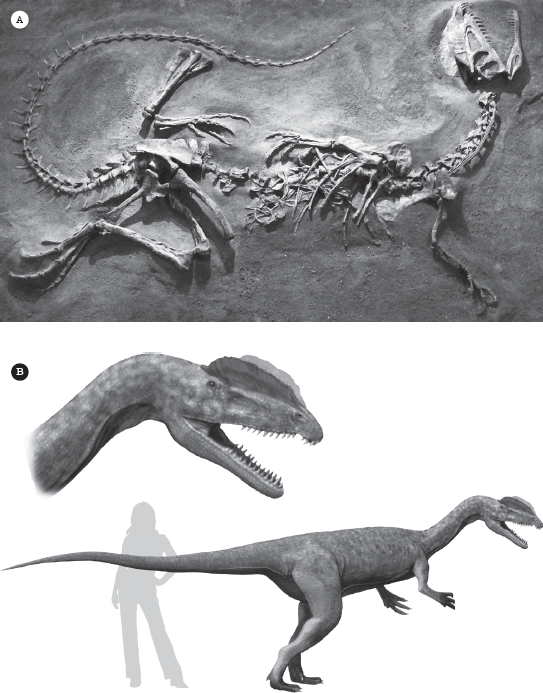
Figure 12.5
Dilophosaurus: (A) the most complete skeleton shown as it was found in an articulated death pose; (B) reconstruction of Dilophosaurus showing the distinctive paired crests along the midline of the head. ([A] Courtesy of Wikimedia Commons; [B] courtesy of N. Tamura)
Dilophosaurus also had a peculiar “gap” in its upper tooth row where the nasal bones were attached to the maxillary bones of the upper jaw. The function of this particular feature is also controversial, but it was not a hinge in the upper jaws, as once thought. Instead, most scientists have pointed out that Dilophosaurus had rather delicate jaws and skull compared to other theropods with heavy robust bony skulls. Some have thought that its rather lightly built skull was better for catching fish and small prey rather than attacking the large prosauropod dinosaurs that lived at the time. Other paleontologists are not so sure. Just as in the pointless argument over Tyrannosaurus rex (see chapter 14), some paleontologists have argued that the weak-jawed Dilophosaurus was merely a scavenger and was not robust enough to be a predator on large prey. But like that problematic argument with other dinosaurs, the real answer is more complex. Nearly all modern large predatory animals (such as lions and hyenas) are both predators and scavengers and will take any meal they can get when they are hungry. For example, lions are known to dine on rotting carcasses, whereas hyenas are good hunters that prefer fresh kills to carrion. Like every other “either/or” argument in paleontology, nature is far more complex, with multiple causes and reasons for just about any feature.
Many people wonder how dinosaurs like Cryolophosaurus survived the cold and chill of Antarctica. The answer is that during the Mesozoic the Antarctic was not cold at all; it had a mild temperate climate. The glaciers of the South Pole are a relatively recent feature, first appearing in the Oligocene about 32 million years ago, and they did not become permanent ice caps until about 14 million years ago. Before those events, the entire planet had a warm “greenhouse” climate, with high carbon dioxide and little or no ice anywhere. Sea levels were relative high through most of the Mesozoic.
The evidence for the mild Antarctic climates came first from fossil plants, which were collected at the very beginning of Antarctic exploration in the ill-fated dash to the South Pole by Robert Falcon Scott in 1912. Among the objects found in their possession by the crews who discovered their frozen bodies were fossil leaves of the seed fern Glossopteris, which was ubiquitous on all the Gondwana continents during the Permian. Many more plants have been found since then. Combined with geochemical evidence from fossil shells, they indicate an average temperature of about 10°C (about 50°F), so they probably experienced a climate much like modern London. The vegetation consisted of many of the trees and plants found in the cold temperate forests of New Zealand and southern South America, including ferns, Araucaria trees (such as the modern Norfolk Island pine and monkey-puzzle tree, both relicts still living Down Under in Australia and New Zealand when they were discovered), ginkgoes, cycads (“sego palms” to gardeners, even though they are conifers, not true palm trees), podocarps, and many other typical Mesozoic plants. Although there were some early flowering plants in the Cretaceous of the polar regions, they were far outnumbered by conifers and other evergreens (as they are today in the subarctic forest or taiga and in the high mountains below the tree line). The climate was only cool temperate with rare episodes of freezing, but it was still dark down there—all the localities are from inside the Antarctic Circle, so they experienced total darkness 24/7 during their winter solstice and remained dark for several months and experienced the “midnight sun” during the peak of summer.
Aside from the Early Jurassic Cryolophosaurus, and a newly discovered primitive sauropod called Glacialisaurus hammeri (discovered by Bill Hammer and crew in 1990–1991 and named and described by Nate Smith in honor of his mentor), only a few other dinosaurs are known from Antarctica. They come from Cretaceous beds and include Antarctopelta, a partial skeleton of an ankylosaur from James Ross Island on the Antarctic Peninsula near Argentina, and some fragments of an ornithopod dinosaur that was named Trinisaura santamartaenesis. The list is very short because collecting fossils in the Antarctic is dangerous, expensive, and limited to just a few months of the year, and there are not many rocks exposed above the ice cap.
Polar dinosaurs are better known from Australia, which also was inside the Antarctic Circle in the Cretaceous. (Australia has since moved north to its present position.) My good friend Tom Rich and his wife Pat have collected Australian dinosaurs for decades and have found some remarkable specimens. They include the small ornithopods Leaellynasaura amicagraphica and Atlascopcosaurus loadsi, the small predatory coelurosaur Timimus hermani, and other small theropods. The meter-long (39-inch) Leaellynasaura (named after Lea Ellyn Rich, the daughter of Tom and Pat Rich) is the most complete fossil of the bunch. It had unusually large eye sockets and large optic lobes in the brain, suggesting that it had huge eyes for seeing in the many months of darkness or semidarkness of the Antarctic winter. Its bones show no growth lines, so it clearly did not hibernate in the winter. Even though polar Australia was dark or dimly lit during the winter, this little herbivore must have found enough food to survive. However, the little coelurosaur Timimus (named after Tim Rich, son of Tom and Pat Rich) did show strong growth lines in its bones, suggesting it did hibernate during the polar winters when conditions were dark and prey was scarce. Most peculiar of all is a weird lower jaw of a tiny shrew-sized mammal from an extinct group distantly related to the living platypus. In addition to these dinosaurs, fish, turtles, pterosaurs, birds, and amphibians were also recovered, which represent an entire ecosystem adapted to months of darkness and cool temperatures.
The mild temperatures were not restricted to the Antarctic; the entire planet was warmer. The Arctic was a region with cool but mild climates and abundant forests and dinosaurs during the Cretaceous as well. However, the dinosaurs were very different. As early as 1961, geologists were finding bones of duck-billed dinosaurs in places like the Colville River of Alaska. When major excavations were undertaken by the University of Alaska, thousands of bones were found, representing 12 species of dinosaurs. Most abundant were the common duckbill from Alberta, similar to Edmontosaurus, which has now been renamed Ugrunaaluk. There were Albertan duckbills such as Kritosaurus and Lambeosaurus as well. Horned dinosaurs included Pachyrhinosaurus, with the flat bony boss on its snout (star of the recent CG movie Walking with Dinosaurs), and the three-horned Anchiceratops. Much less common were pachycephalosaurs, dinosaurs with a thick boss of bone over their tiny brains, and the other herbivores including Thescelosaurus, an ornithopod dinosaur. Their predators included the Albertan tyrannosaur Albertosaurus, plus typical Alberta and Montana theropods such as Troodon, Dromaeosaurus, and Saurornitholestes.
Like the Antarctic Cretaceous dinosaurs, they lived in a world with cool temperatures suitable for conifers such as bald cypress, cycads, ginkgoes, ferns, and horsetails. The temperatures in Cretaceous Alaska (based on plants and also on geochemistry) averaged about 5°C (41°F) with summer means around 10°C (50°F), and winter temperatures around freezing. Like the dinosaurs of the Antarctic, these dinosaurs lived within the Arctic Circle, so they experienced many months of near darkness. Unlike those in the Australia-Antarctic continent, however, it is possible that many of the dinosaurs (especially the duckbills) migrated down to warm Alberta to escape the cold dark winters.
This was the greenhouse world of the Age of Dinosaurs. The planet was warm to the poles with no ice, high sea levels, and lots of different animals living in conifer and fern cool temperate forests within a few miles of the North Pole.
FOR FURTHER READING
Colbert, Edwin. Digging Into the Past: An Autobiography. New York: Dembner Books, 1989.
——. A Fossil Hunter’s Notebook: My Life with Dinosaurs and Other Friends. New York: Dutton, 1980.
Farlow, James, and M. K. Brett-Surman. The Complete Dinosaur. Bloomington: Indiana University Press, 1999.
Fastovsky, David, and David Weishampel. Dinosaurs: A Concise Natural History, 3rd ed. Cambridge: Cambridge University Press, 2016.
Holtz, Thomas R., Jr. Dinosaurs: The Most Complete, Up-to-Date Encyclopedia for Dinosaur Lovers of All Ages. New York: Random House, 2011.
Naish, Darren, and Paul M. Barrett. Dinosaurs: How They Lived and Evolved. Washington, D.C.: Smithsonian Books, 2016.
Prothero, Donald R. Greenhouse of the Dinosaurs: Evolution, Extinction, and the Future of the Planet. New York: Columbia University Press, 2009.
Rich, Thomas, and Patricia Vickers Rich. Dinosaurs of Darkness. Bloomington: Indiana University Press, 2000.
Walker, Sally M. The Search for Antarctic Dinosaurs. New York: Millbrook Press, 2007.